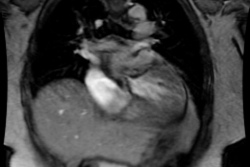Congenital Critical Aortic Stenosis:
Clinical:
There are 3 types of lesions: 1- Valvular; 2- Subvalvular; and 3- Supravalvular (rare).1- Valvular critical aortic stenosis: Most common and usually secondary to a bicuspid valve with fusion of the valve cusps. This lesion is associated with aortic coarctation and endocardial fibroelastosis. Affected neonates/infants present with severe CHF. There is usually an associated left to right shunt (ASD/VSD). Treatment of critical valvular aortic stenosis is with surgical valvotomy or percutaneous balloon valvotomy. The CXR usually demonstrates cardiomegaly and vascular congestion.
2- Subvalvular: More commonly subvalvular aortic stenosis is related to idiopathic hypertrophic subaortic stenosis, but it can also occur as a result of a fixed congenital abnormality. The fixed lesion can be either a thin, fibrous membrane (type I- 80% of cases), a fibrotic ring (type II), fibromuscular tissue (type III), or a thick, tunnel-like long fibromuscular band/stricture (type IV) [1,3]. This lesion is often associated with aortic insufficiency, VSD, and aortic coarctation [1]. Most patients present after infancy for the evaluation of a heart murmur. The lesion is more common in males [3]. Left ventricular hypertrophy is found in 65-85% of patients. The CXR is usually normal. Treatment is recommended for symptomatic patients or in those with an LVOT gradient of more than 50 mm Hg [3]. Treatment is surgical myomectomy and resection of the subvalvular membrane [1].
3- Supravalvular (SVAS): There is a focal or diffuse narrowing of the aorta starting at the sinotubular junction and often involving the entire ascending aorta (15% of cases) [2]. The lesion is commonly associated with Williams-Beuren syndrome- an autosomal dominant multisystemic disorder associated with SVAS in 71% of cases [2]. SVAS can also occur as an autosomal inherited form or as a rare sporadic form [2]. In all cases, there is a mutation of the elastin gene on chromosome 7q11.23 that results in reduction and disorganization of elastin fibers within the aortic media accompanied by hypertrophied smooth muscle cells and increased collagen content [2]. Aortic valve abnormalities occur in 50% of patients- most commonly a bicuspid aortic valve [2]. Associated subaortic stenosis is reported in 16% of cases [2]. Surgical correction is indicated in symptomatic patients (those with angina, dyspnea, or syncope) or those with a mean pressure gradient of greater than or equal to 50 mm Hg [2]. In patients with Williams syndrome the SVAS can show regression without intervention [2].
REFERENCES:
(1) Pediatric Clinics of North America 1999; Fedderly RT. Left
ventricular
outflow obstruction. 46 (2): 369-384
(2) Radiographics 2010; Kimura-Hayama ET, et al. Uncommon
congenital and acquired aortic diseases: role of multidetector CT
angiography. 30: 79-98
(3) Radiographics 2019; Rajiah P, et al. Bands in the heart: multimodality imaging review. 39: 1238-1263





